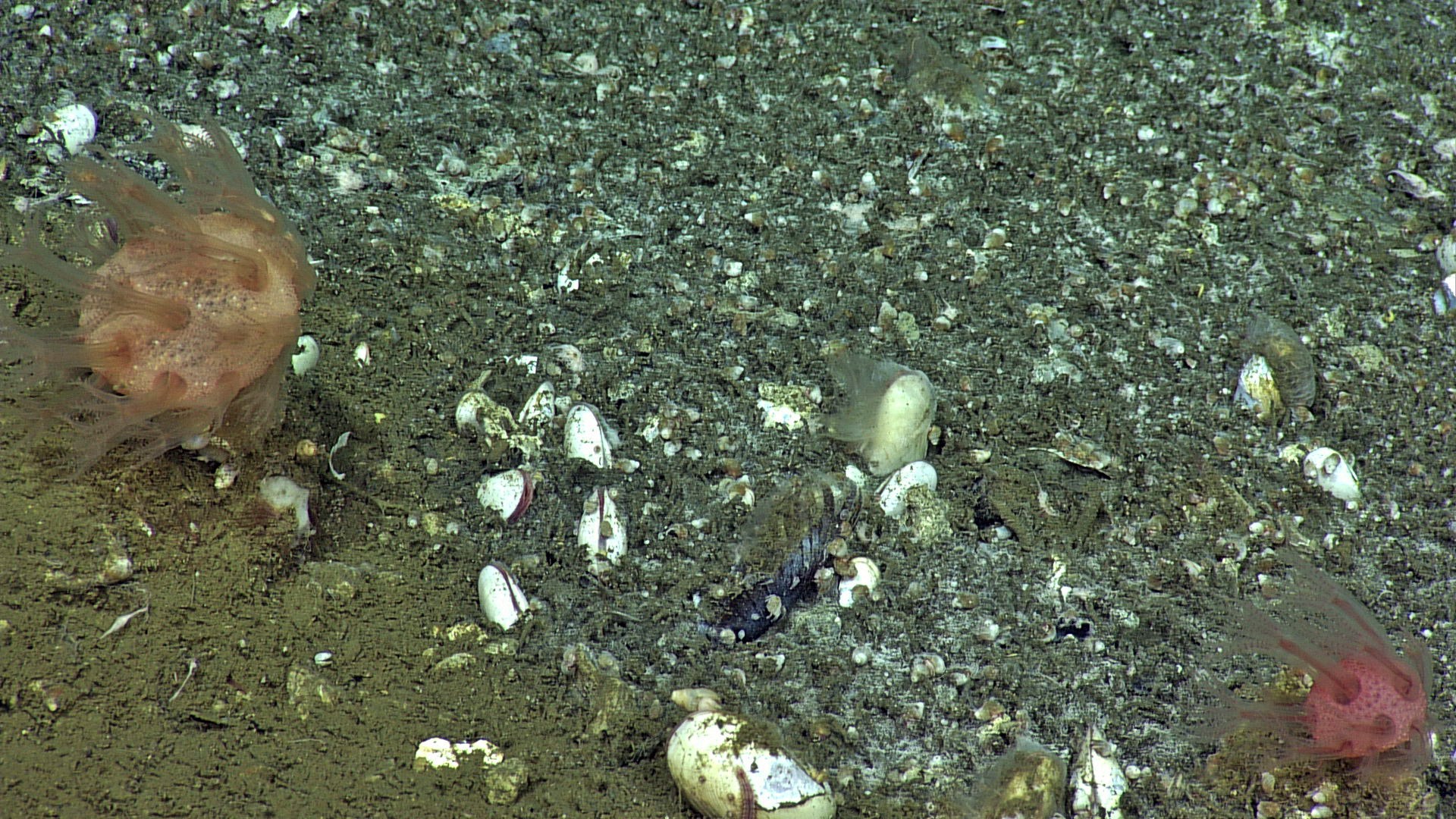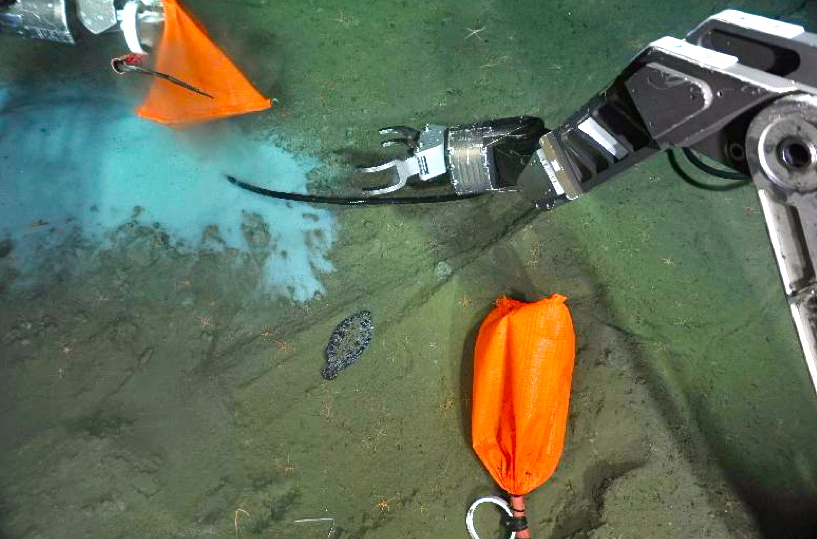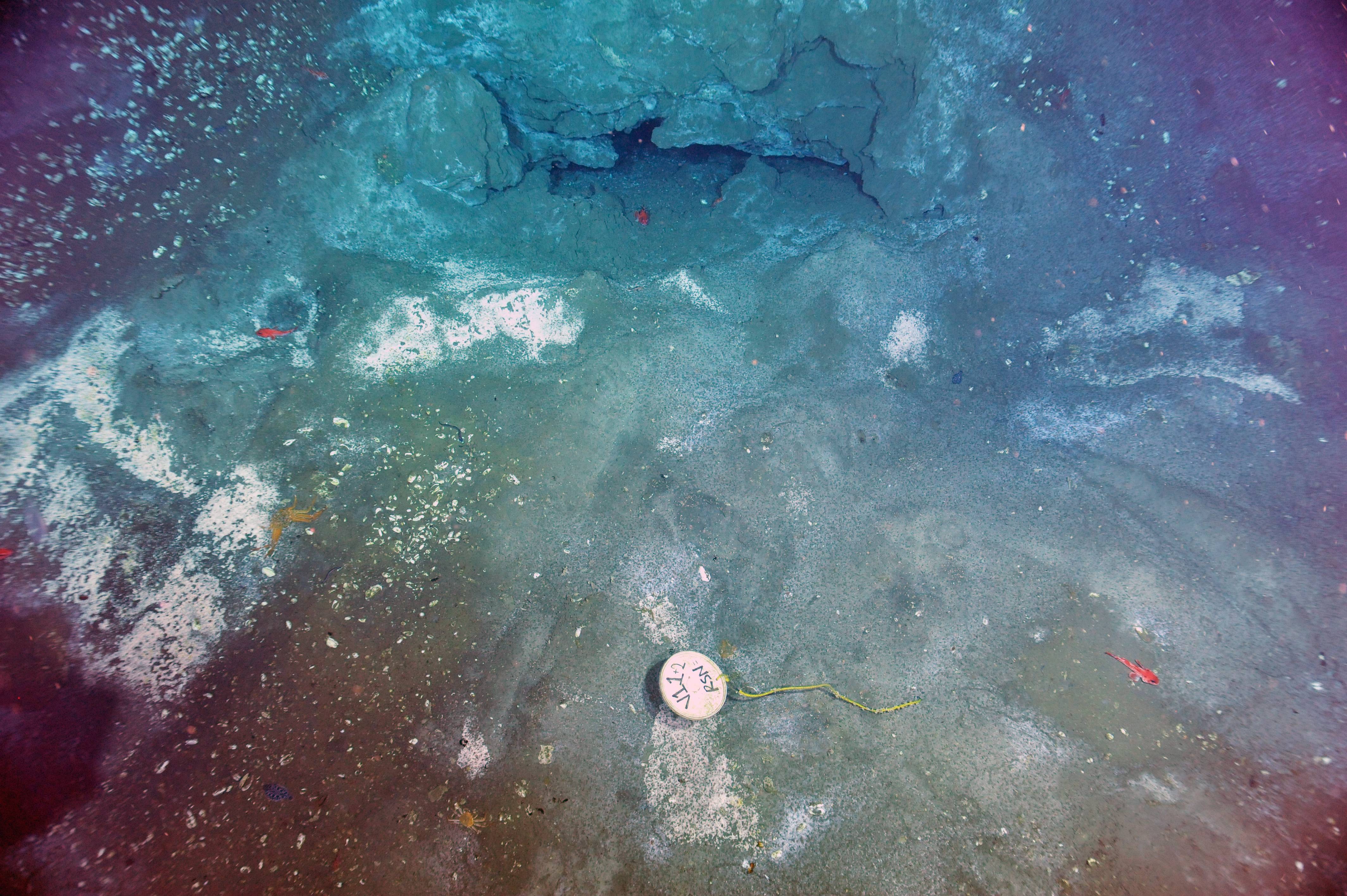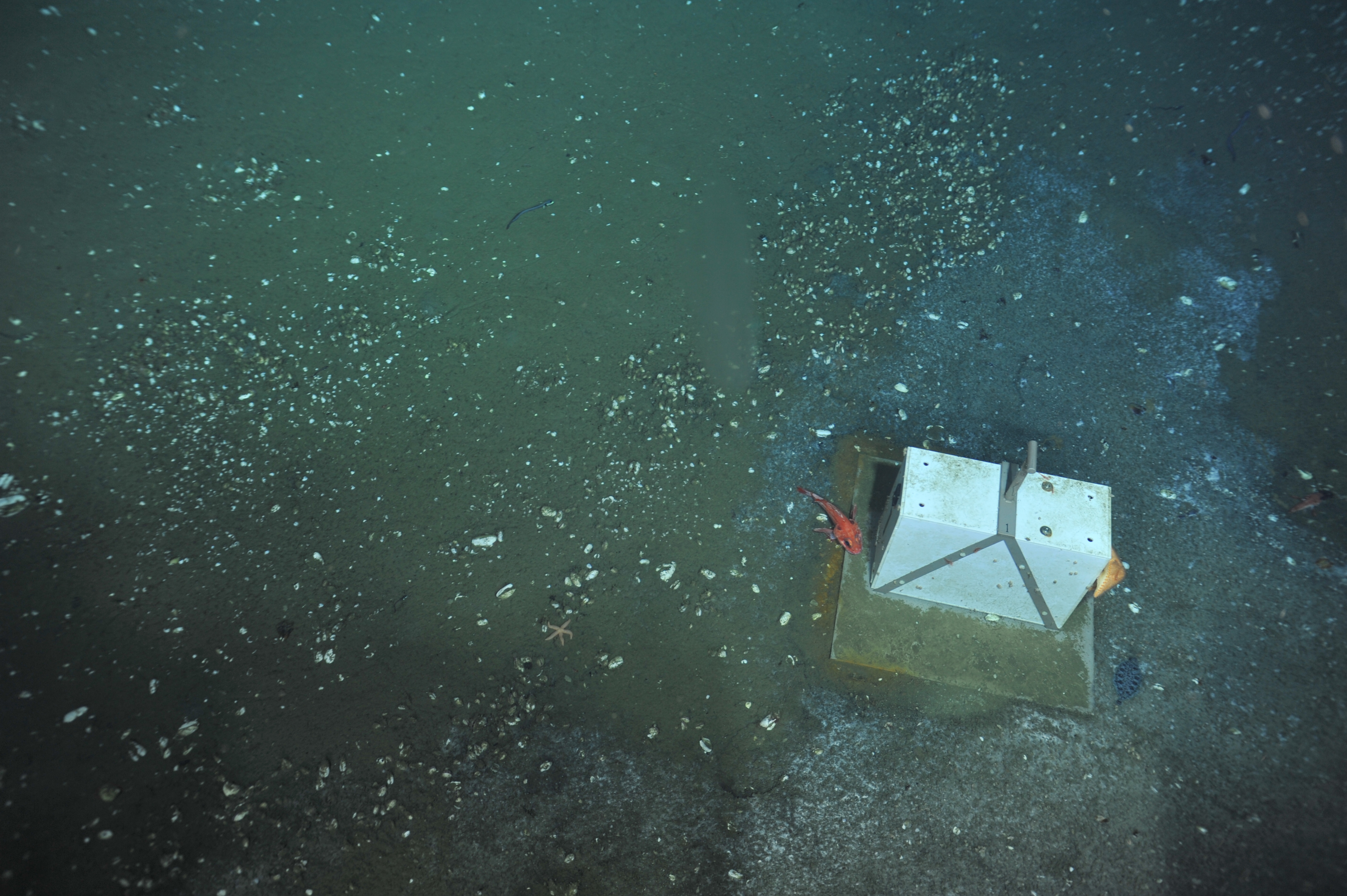Image Archive





























The Neptunea nursery in 2015 was devoid of tending snails on top of the egg stalks. Recovery of the stalks showed that the eggs are still viable. Credit: NSF-OOI/UW/ISS, Dive R1845, V15.

Deb brings in a recovered carbonate cobble with egg casings of Neptunea snails from Southern Hydrate Ridge. The eggs can take up to 1 year to hatch. Credit: Mitch Elend, University of Washington, V15.

A before and after image of the fantail on the R/V Thompson the day we left port (August 26) and came back (September 10). In between these two port calls, we came back into Newport and loaded another complete set of gear to install on the seafloor. Photo Credit: Mitch Elend, University of Washington, V14.

The ROV ROPOS samples jets of methane bubbles with a hand-held Niskin bottle. Photo credit: NSF-OOI/UW/CSSF; Dive R1784; V14.

The manipulator arm of the ROV ROPOS reaches for a small block of methane hydrate wedged against a small rampart and nearly vertical wall within a large collapsed area at the summit of Southern Hydrate Ridge. Several minutes after sampling this site with the ROV, a continuous jet of methane bubbles issued from the large opening to the right of the hydrate sample. The methane hydrate is translucent, very clean and is reminscent of quartz with a conchoidal-like fracture pattern and is partially encased in a thin skin of sediment. Credit: UW/NSF-OOI/CSSF; ROPOS Dive R1784; V14.

Mola mola, a sunfish, are the heaviest known bony fish. They can weigh ~2000 lbs - they mainly eat jellyfish. Credit: Billy Medwedeff, University of Washington; V14.

Soft corals dot the rough carbonate surfaces of the ~ 60 m-tall limestone monolith west of the active seeps at Southern Hydrate Ridge. Credit: UW/NSF-OOI/CSSF; ROPOS Dive R1779; V14.

A broadband seismometer installed inside a buried cassion at Southern Hydrate Ridge by the ROV ROPOS. A follow-on dive will fill the caisson with silica beads, which dampens noise. The broadband and low frequency hydrophone is installed here to detect both large and small earthquakes that may impact the release of methane gas into the hydrosphere. Credit: UW/NSF-OOI/CSSF; ROPOS Dive R1779; V14.

An ~60 m tall carbonate pinnacle, west of the active seep site at Southern Hydrate Ridge, hosts abundant soft pink corals and is a rich habitat for squat lobsters, clams, a variety of fish, and crabs. Credit: UW/NSF-OOI/CSSF; Dive R1779; V14.

Soft corals bend in the currents at the edge of a bacterial mat. Here, live clams with symbionts thrive in the methane and hydrogen sulfide-rich fluids. Credit: UW/NSF-OOI/CSSF; ROPOS Dive R1773; V14.

An in situ, cabled mass spectrometer is installed at a methane seep at the summit of Southern Hydrate Ridge. The OOI-RCA mass spectrometer was built by Peter Girguis, Harvard University. Credit: UW/NSF-OOI/CSSF; ROPOS Dive R1772; V14.

A Starry Flounder hangs out during installation of short-period seismometers at Southern Hydrate Ridge. Credit: UW/NSF-OOI//CSSF; ROPOS Dive R1769; V14.

Hagfish (purple), red rockfish, crabs, and hermit crabs wander within the nusery for Neptunea snails laying eggs that form yellow stocks on carbonate cobbles. Southern Hydrate Ridge. Credit: UW/NSF-OOI/CSSF; ROPOS Dive R1766; V14.

The digital still camera (CAMDSB103) sits atop a small, heavilysedimented rampart in front of the actively venting methane seep Einstein's Grotto at the summit of Southern Hydrate Ridge. Credit: UW/NSF-OOI/CSSF; ROPOS Dive R1767; V14.

A rockfish and hemit crabs hang out in a nursery of Neptunea snails at the summit of Southern Hydrate Ridge.The snail stalks rise from small carbonate cobbles. Photo credit: UW/NSF-OOI/CSSF; ROPOS Dive R1766; V14.

Einstein's Grotto changes rapidly over hours to days. Revisitation of the active seep site today showed that a large sedimentary protrusion at the vent opening had desintegrated and a large and vigorous bubble plume was exiting the orifice.Photo credit: NSF-OOI/UW/CSSF; Dive R1761; V14.

A strong bubble plume issues from Einstein's Grotto early morning of August 29, 2014. Photo credit: NSF-OOI/UW/CSSF; Dive R1761; V14.

Close up of a Neptunea snail on its egg stalk at the summit of Southern Hydrate Ridge. Credit: UW/NSF-OOI/CSSF; ROPOS Dive R1758; V14.

A nursery of Neptunea snails rest atop their egg stalks, babysitting them until the adult snails die and fall off the stalks. The eggs are laid on small carbonate cobbles. Rockfish, sole, spider crabs, and hermit crabs wander through the forest of stalks. Photo credit: NSF-OOI/UW/CSSF; Dive R1758; V14.

A methane bubble plume west of Einstein's Grotto at Southern Hydrate Ridge Summit. Credit: UW/NSF-OOI/CSSF, Dive R1754, V14.

Exposed gas hydrate (a clathrate of water ice that forms around methane) observed in Einstein,s Grotto at the Southern Hydrate Ridge summit. Large bubbles were escaping intermittently from the crevice, indicating an active methane seep. A rockfish is sheltering within the grotto as well. Credit: UW/NSF-OOI//CSSF, ROPOS Dive R1754, VI14.

We encountered a little piece of Monterey Bay Aquarium Research Institute (MBARI) at Hydrate Ridge during survey dive R1754. The flamingo has seen better days, but it is also now hosting some invertebrate friends. Photo Credit: NSF-OOI/UW/CSSF, Dive R1754, VISIONS14

An eelpout resting on the sediment at Hydrate Ridge, near Einstein's Grotto. Photo Credit: NSF-OOI/UW/CSSF, Dive R1750, V14

A CAT flow meter near Einstein's Grotto. It is home to a rockfish and sea star. Photo Credit: NSF-OOI/UW/CSSF, Dive R1750, V14

A spiny pink crab (missing a rear leg) seen at Hydrate Ridge, near Einstein's Grotto. Photo Credit: NSF-OOI/UW/CSSF, Dive R1750, V14

A pair of hermit crabs (possibly mating?) at Hydrate Ridge, near Einstein's Grotto. Photo Credit: NSF-OOI/UW/CSSF, Dive R1750, V14

A caisson lid at Southern Hydrate Ridge decorated with an octopus and a Basho haiku during a previous VISIONS cruise. Credit: UW/NSF-OOI//CSSF, ROPOS Dive R1750, V14.

Replacing the caisson cover at Southern Hydrate Ridge, after inspecting the eventual deployment location of a seismometer at that site. The caisson (the hole in the sediment at center) was excavated using a suction tube attached to the ROV during a previous expedition. Credit: UW/NSF-OOI//CSSF, ROPOS ROPOS Dive R1750, V14.
- Anemone
- Animal
- Arthropod
- ASHES
- Axial
- Axial Base
- Axial Biology
- Axial Caldera
- Bacteria
- Basalt Lava
- BEP
- Biofouling
- biolgoy
- Biology
- Camds
- Camera
- Camhd
- Central Caldera
- Ciliates
- Cnidaria
- Coastal Biology
- Crab
- Deep Profiler Mooring
- Dive Highlights
- Eastern Caldera
- Echinoderms
- Endurance Array
- Engineering Team
- ENLIGHTEN 10
- Exploratorium
- Fish
- Geology
- HD Camera
- HPIES
- Hydrate Ridge
- Hydrates
- Hydrophone
- Hydrothermal Vents
- Illustration
- Inshore 80 Meters
- Instrument
- International District
- J-BOX
- Jason
- Jellyfish
- Junction Box
- K12
- Lava
- Mollusk
- Moorings
- Nodes
- Nudibranch
- Octopus
- OOI
- Oregon Offshore
- Oregon Offshore 600 m
- Oregon Shelf
- Oregon Slope Base
- People
- PN1B
- PN1D
- Polychaetes
- PPSDN
- Primary Node
- RASFL
- ROCLS
- ROPOS
- ROPOS Dives
- ROV Team
- RV Revelle
- RV Sikuliaq
- RV Thompson
- Salp
- Sample
- SC13
- Science Team
- Sea Cucumber
- Sea Star
- Sea Urchin
- Seafloor
- Seismometer
- Sensors
- Shallow Profiler Mooring
- Shark
- Shipboard
- Shore Station
- Slope Base
- Smoker
- Soft Coral
- Southern Hydrate Ridge
- Sponge
- Squid
- Students
- Students & Guest Participants
- Tmpsf
- Tubeworms
- VISIONS 11 Leg 1
- VISIONS 11 Leg 2
- VISIONS 11 Viewers
- VISIONS 13
- VISIONS 14
- VISIONS 15
- VISIONS 16
- VISIONS 17
- VISIONS 18
- VISIONS 20
- VISIONS 22
- VISIONS 23
- Visualization
